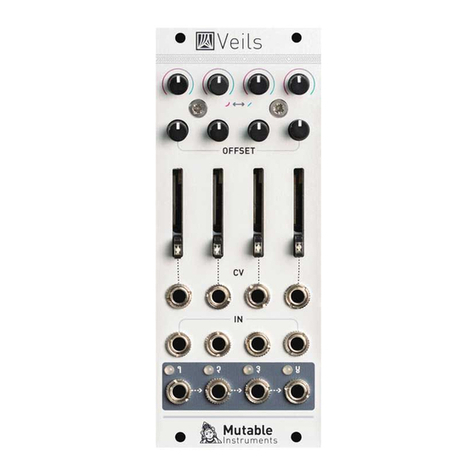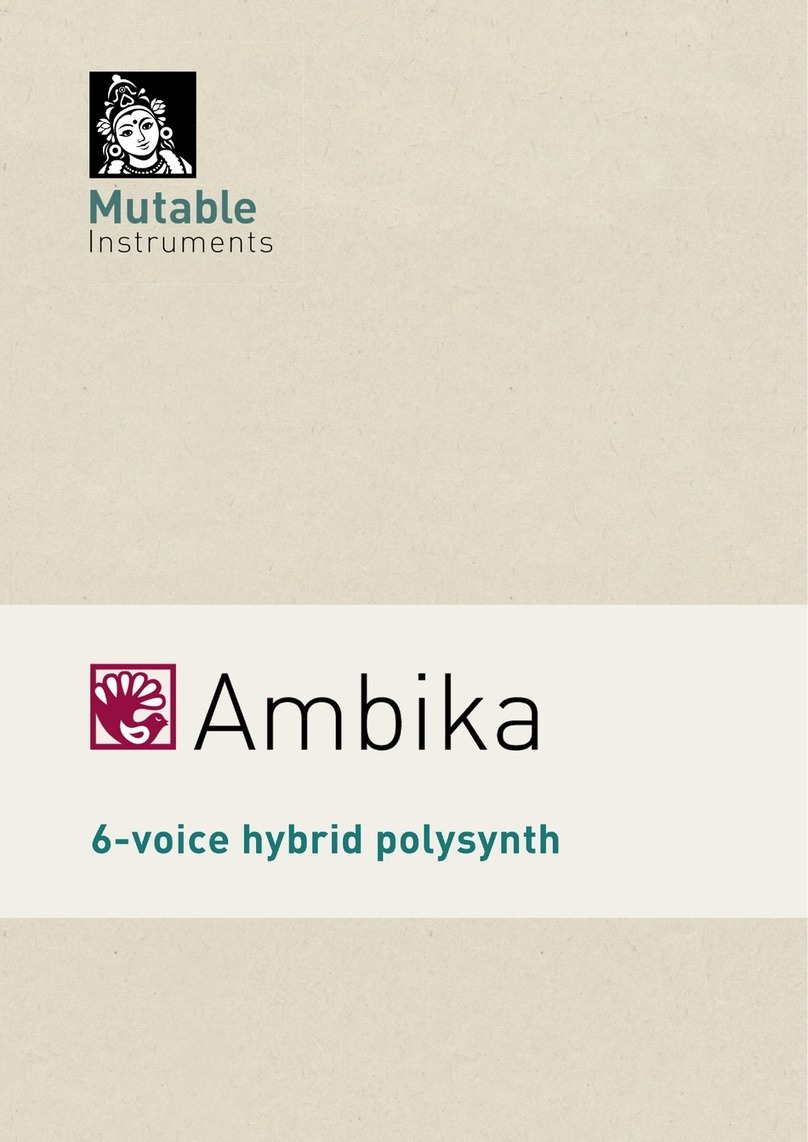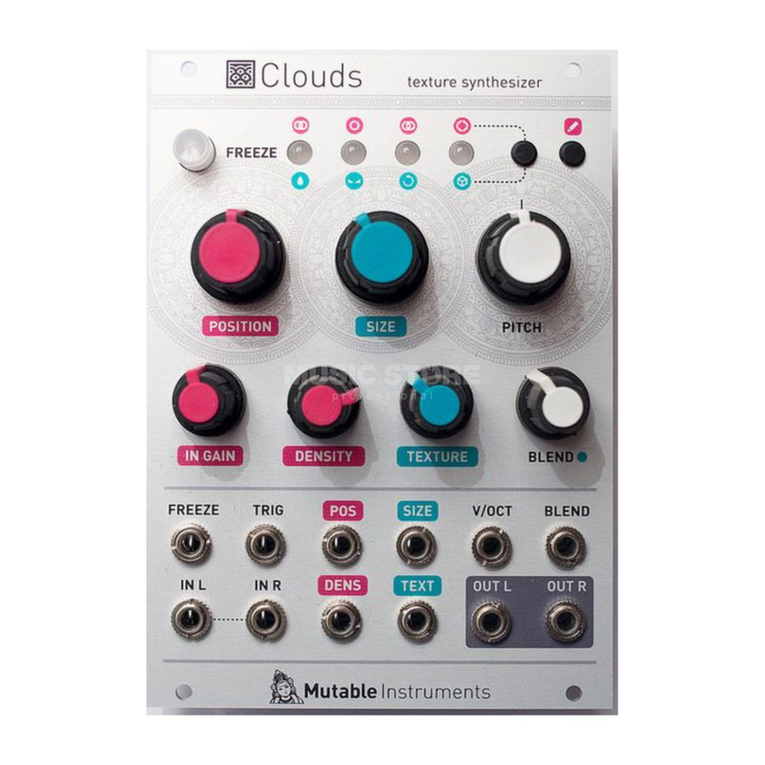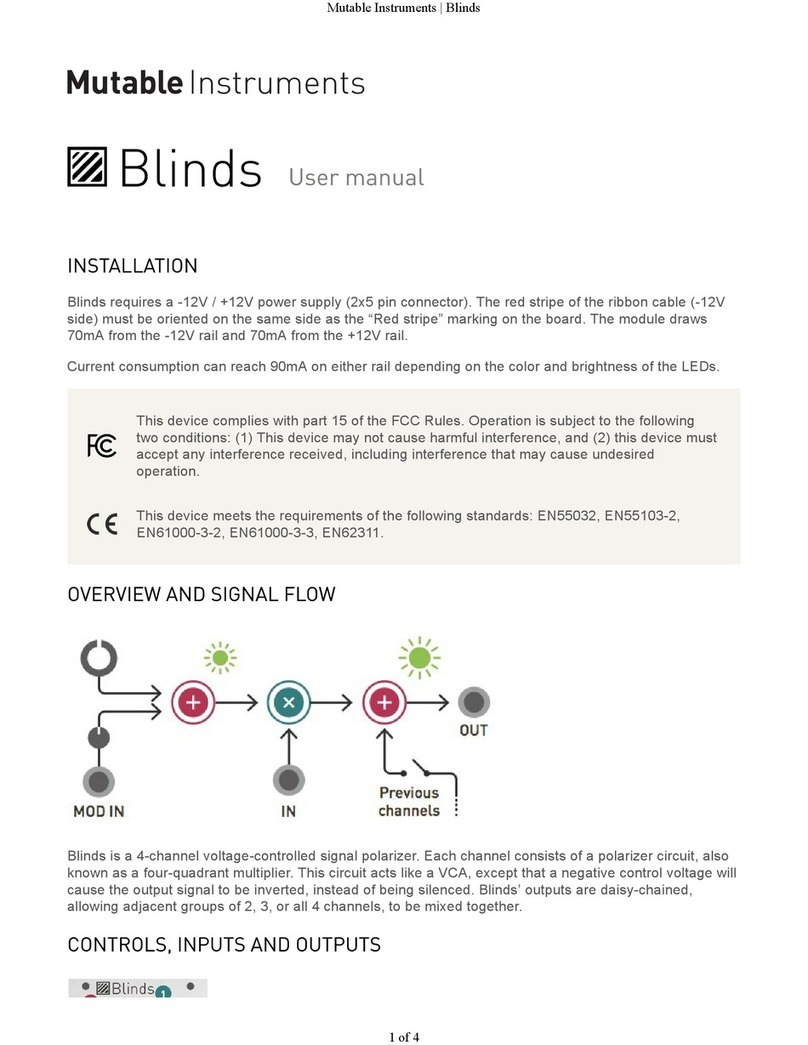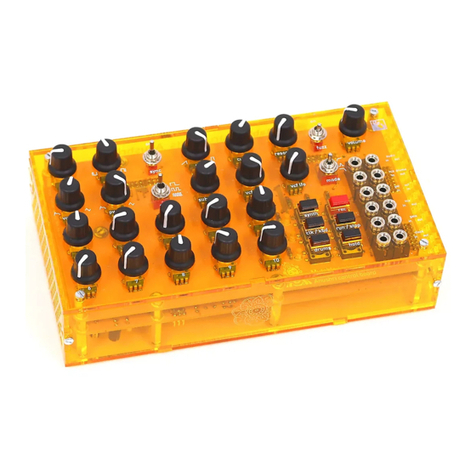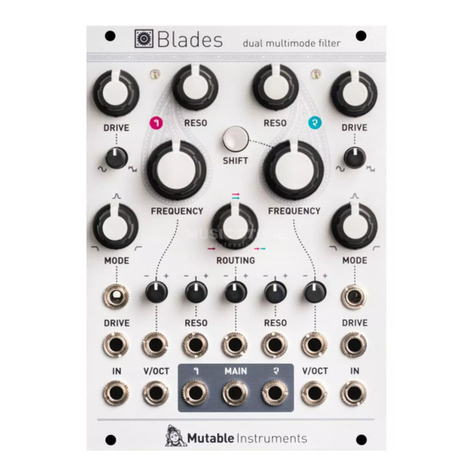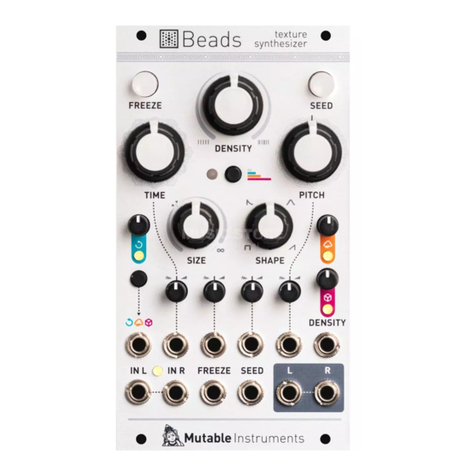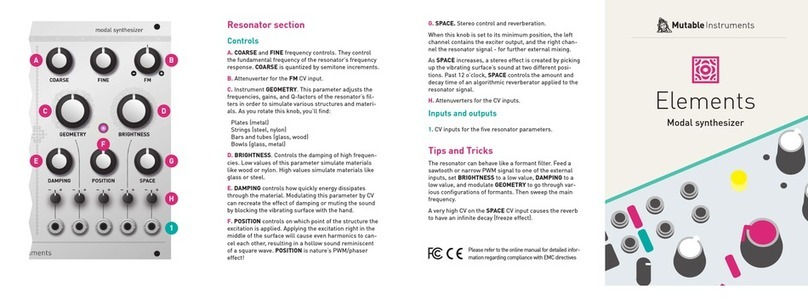
Vibrato rate controls the speed of the vibrato LFO. The amplitude of this LFO is directly controlled by the
modulation wheel of the MIDI keyboard.
Vibrato destination controls the destination of the vibrato LFO. When this control is set to its minimum value,
the vibrato LFO affects the pitch (actual vibrato). When this control is set to its maximum value, the vibrato LFO
affects the cutoff frequency (“growl” or “wah-wah” effect). In the middle position, both the VCO and VCF are
affected.
Velocity destination indicates how MIDI note velocity affects the sound. When this control is set to its minimum
value, velocity affects cutoff frequency (the harder the key is pressed, the more open the filter is). When this
control is set to its maximum value, velocity affects VCA level (the harder the key is pressed, the louder the
sound is). In the middle position, velocity has no effect on sound.
Latch and hold, jamming without MIDI keyboard
While some keys are pressed on the MIDI keyboard, press the Hold button to keep them held. LEDs will be
temporarily dimmed. Press Hold again to release them. This can be used as a “latch” function for the
arpeggiator, freeing your hands to tweak the knobs while an arpeggio is being held… or simply to create a drone
tone.
The Hold function hides another mystery… Even if Anushri has been designed as a MIDI synth module, it is still
possible to play it without an external keyboard or sequencer. Hold the Hold button for 2 seconds. A note starts
playing. Turn the 5 knobs on the last row to step through scales. Press the Hold button again to leave this mode.
This “knob jamming” mode can even be triggered while the sequencer is recording, and provides a fun way of
letting your toddlers, pets or significant other input random but musically coherent (or not) sequences.
DRUM SYNTH AND GENERATIVE DRUM MACHINE
Overview
Anushri has a built-in drum synth and generative drum sequencer which can be played along with the synth
section and its arpeggiator/sequencer.
The drum synth comprises three parts, for bass drum (BD), snare drum (SD), and closed high-hat (HH). The
bass drum and snare drum sounds are generated digitally, using a pitch and amplitude modulated digital
oscillator and a noise source. The high-hat uses sample playback with variable speed, and an amplitude
envelope.
The drum machine is playing when the sequencer is running. If you want to play freely (or with the arpeggiator)
on top of the drum machine, record an empty sequence - Rec, Rec - and press Run/stop to start the drum
machine.
Understanding the generative sequencer
The sequencer controlling the drum section is unlike anything else. It is neither based on x0x-style step
programming, nor on presets. It is mostly played by knobs. How does it work? Let us introduce two concepts.
Style map
One sleepless night, you have the crazy idea of tiling the floor of your apartment with your CD collection. You
start taking the CDs and putting them on the floor, and then, come up with the idea of grouping them
“stylistically”… Wouldn’t it be great if CDs of bands that sound similar would be laid out close to each other? All
the old-school Techno up north, hip-hop south, with maybe some big-beat of trip-hop in the middle, and an island
of jazz on the east. What’s great with this arrangement, where objects physically close to each other are
sonically related to each other, is that tracing a path through the space would leave a continuous playlist with
interesting transitions from one artist to the other…
Now imagine doing the same thing with the collection of drum loops on your hard-drive… All variants of the
Amen break would be clustered together, farther apart from the 909 house loops.
There are indeed mathematical techniques to do this kind of arrangements and this is exactly how Anushri
stores and organizes drum patterns. In the darkness of the Mutable Instruments labs, we have compiled many
drum patterns, tiled them into a 2D map so that nearby patterns occupy nearby cells.
Vibrato rate controls the speed of the vibrato LFO. The amplitude of this LFO is directly controlled by the
modulation wheel of the MIDI keyboard.
Vibrato destination controls the destination of the vibrato LFO. When this control is set to its minimum value,
the vibrato LFO affects the pitch (actual vibrato). When this control is set to its maximum value, the vibrato LFO
affects the cutoff frequency (“growl” or “wah-wah” effect). In the middle position, both the VCO and VCF are
affected.
Velocity destination indicates how MIDI note velocity affects the sound. When this control is set to its minimum
value, velocity affects cutoff frequency (the harder the key is pressed, the more open the filter is). When this
control is set to its maximum value, velocity affects VCA level (the harder the key is pressed, the louder the
sound is). In the middle position, velocity has no effect on sound.
Latch and hold, jamming without MIDI keyboard
While some keys are pressed on the MIDI keyboard, press the Hold button to keep them held. LEDs will be
temporarily dimmed. Press Hold again to release them. This can be used as a “latch” function for the
arpeggiator, freeing your hands to tweak the knobs while an arpeggio is being held… or simply to create a drone
tone.
The Hold function hides another mystery… Even if Anushri has been designed as a MIDI synth module, it is still
possible to play it without an external keyboard or sequencer. Hold the Hold button for 2 seconds. A note starts
playing. Turn the 5 knobs on the last row to step through scales. Press the Hold button again to leave this mode.
This “knob jamming” mode can even be triggered while the sequencer is recording, and provides a fun way of
letting your toddlers, pets or significant other input random but musically coherent (or not) sequences.
DRUM SYNTH AND GENERATIVE DRUM MACHINE
Overview
Anushri has a built-in drum synth and generative drum sequencer which can be played along with the synth
section and its arpeggiator/sequencer.
The drum synth comprises three parts, for bass drum (BD), snare drum (SD), and closed high-hat (HH). The
bass drum and snare drum sounds are generated digitally, using a pitch and amplitude modulated digital
oscillator and a noise source. The high-hat uses sample playback with variable speed, and an amplitude
envelope.
The drum machine is playing when the sequencer is running. If you want to play freely (or with the arpeggiator)
on top of the drum machine, record an empty sequence - Rec, Rec - and press Run/stop to start the drum
machine.
Understanding the generative sequencer
The sequencer controlling the drum section is unlike anything else. It is neither based on x0x-style step
programming, nor on presets. It is mostly played by knobs. How does it work? Let us introduce two concepts.
Style map
One sleepless night, you have the crazy idea of tiling the floor of your apartment with your CD collection. You
start taking the CDs and putting them on the floor, and then, come up with the idea of grouping them
“stylistically”… Wouldn’t it be great if CDs of bands that sound similar would be laid out close to each other? All
the old-school Techno up north, hip-hop south, with maybe some big-beat of trip-hop in the middle, and an island
of jazz on the east. What’s great with this arrangement, where objects physically close to each other are
sonically related to each other, is that tracing a path through the space would leave a continuous playlist with
interesting transitions from one artist to the other…
Now imagine doing the same thing with the collection of drum loops on your hard-drive… All variants of the
Amen break would be clustered together, farther apart from the 909 house loops.
There are indeed mathematical techniques to do this kind of arrangements and this is exactly how Anushri
stores and organizes drum patterns. In the darkness of the Mutable Instruments labs, we have compiled many
drum patterns, tiled them into a 2D map so that nearby patterns occupy nearby cells.
Vibrato rate controls the speed of the vibrato LFO. The amplitude of this LFO is directly controlled by the
modulation wheel of the MIDI keyboard.
Vibrato destination controls the destination of the vibrato LFO. When this control is set to its minimum value,
the vibrato LFO affects the pitch (actual vibrato). When this control is set to its maximum value, the vibrato LFO
affects the cutoff frequency (“growl” or “wah-wah” effect). In the middle position, both the VCO and VCF are
affected.
Velocity destination indicates how MIDI note velocity affects the sound. When this control is set to its minimum
value, velocity affects cutoff frequency (the harder the key is pressed, the more open the filter is). When this
control is set to its maximum value, velocity affects VCA level (the harder the key is pressed, the louder the
sound is). In the middle position, velocity has no effect on sound.
Latch and hold, jamming without MIDI keyboard
While some keys are pressed on the MIDI keyboard, press the Hold button to keep them held. LEDs will be
temporarily dimmed. Press Hold again to release them. This can be used as a “latch” function for the
arpeggiator, freeing your hands to tweak the knobs while an arpeggio is being held… or simply to create a drone
tone.
The Hold function hides another mystery… Even if Anushri has been designed as a MIDI synth module, it is still
possible to play it without an external keyboard or sequencer. Hold the Hold button for 2 seconds. A note starts
playing. Turn the 5 knobs on the last row to step through scales. Press the Hold button again to leave this mode.
This “knob jamming” mode can even be triggered while the sequencer is recording, and provides a fun way of
letting your toddlers, pets or significant other input random but musically coherent (or not) sequences.
DRUM SYNTH AND GENERATIVE DRUM MACHINE
Overview
Anushri has a built-in drum synth and generative drum sequencer which can be played along with the synth
section and its arpeggiator/sequencer.
The drum synth comprises three parts, for bass drum (BD), snare drum (SD), and closed high-hat (HH). The
bass drum and snare drum sounds are generated digitally, using a pitch and amplitude modulated digital
oscillator and a noise source. The high-hat uses sample playback with variable speed, and an amplitude
envelope.
The drum machine is playing when the sequencer is running. If you want to play freely (or with the arpeggiator)
on top of the drum machine, record an empty sequence - Rec, Rec - and press Run/stop to start the drum
machine.
Understanding the generative sequencer
The sequencer controlling the drum section is unlike anything else. It is neither based on x0x-style step
programming, nor on presets. It is mostly played by knobs. How does it work? Let us introduce two concepts.
Style map
One sleepless night, you have the crazy idea of tiling the floor of your apartment with your CD collection. You
start taking the CDs and putting them on the floor, and then, come up with the idea of grouping them
“stylistically”… Wouldn’t it be great if CDs of bands that sound similar would be laid out close to each other? All
the old-school Techno up north, hip-hop south, with maybe some big-beat of trip-hop in the middle, and an island
of jazz on the east. What’s great with this arrangement, where objects physically close to each other are
sonically related to each other, is that tracing a path through the space would leave a continuous playlist with
interesting transitions from one artist to the other…
Now imagine doing the same thing with the collection of drum loops on your hard-drive… All variants of the
Amen break would be clustered together, farther apart from the 909 house loops.
There are indeed mathematical techniques to do this kind of arrangements and this is exactly how Anushri
stores and organizes drum patterns. In the darkness of the Mutable Instruments labs, we have compiled many
drum patterns, tiled them into a 2D map so that nearby patterns occupy nearby cells.
Vibrato rate controls the speed of the vibrato LFO. The amplitude of this LFO is directly controlled by the
modulation wheel of the MIDI keyboard.
Vibrato destination controls the destination of the vibrato LFO. When this control is set to its minimum value,
the vibrato LFO affects the pitch (actual vibrato). When this control is set to its maximum value, the vibrato LFO
affects the cutoff frequency (“growl” or “wah-wah” effect). In the middle position, both the VCO and VCF are
affected.
Velocity destination indicates how MIDI note velocity affects the sound. When this control is set to its minimum
value, velocity affects cutoff frequency (the harder the key is pressed, the more open the filter is). When this
control is set to its maximum value, velocity affects VCA level (the harder the key is pressed, the louder the
sound is). In the middle position, velocity has no effect on sound.
Latch and hold, jamming without MIDI keyboard
While some keys are pressed on the MIDI keyboard, press the Hold button to keep them held. LEDs will be
temporarily dimmed. Press Hold again to release them. This can be used as a “latch” function for the
arpeggiator, freeing your hands to tweak the knobs while an arpeggio is being held… or simply to create a drone
tone.
The Hold function hides another mystery… Even if Anushri has been designed as a MIDI synth module, it is still
possible to play it without an external keyboard or sequencer. Hold the Hold button for 2 seconds. A note starts
playing. Turn the 5 knobs on the last row to step through scales. Press the Hold button again to leave this mode.
This “knob jamming” mode can even be triggered while the sequencer is recording, and provides a fun way of
letting your toddlers, pets or significant other input random but musically coherent (or not) sequences.
DRUM SYNTH AND GENERATIVE DRUM MACHINE
Overview
Anushri has a built-in drum synth and generative drum sequencer which can be played along with the synth
section and its arpeggiator/sequencer.
The drum synth comprises three parts, for bass drum (BD), snare drum (SD), and closed high-hat (HH). The
bass drum and snare drum sounds are generated digitally, using a pitch and amplitude modulated digital
oscillator and a noise source. The high-hat uses sample playback with variable speed, and an amplitude
envelope.
The drum machine is playing when the sequencer is running. If you want to play freely (or with the arpeggiator)
on top of the drum machine, record an empty sequence - Rec, Rec - and press Run/stop to start the drum
machine.
Understanding the generative sequencer
The sequencer controlling the drum section is unlike anything else. It is neither based on x0x-style step
programming, nor on presets. It is mostly played by knobs. How does it work? Let us introduce two concepts.
Style map
One sleepless night, you have the crazy idea of tiling the floor of your apartment with your CD collection. You
start taking the CDs and putting them on the floor, and then, come up with the idea of grouping them
“stylistically”… Wouldn’t it be great if CDs of bands that sound similar would be laid out close to each other? All
the old-school Techno up north, hip-hop south, with maybe some big-beat of trip-hop in the middle, and an island
of jazz on the east. What’s great with this arrangement, where objects physically close to each other are
sonically related to each other, is that tracing a path through the space would leave a continuous playlist with
interesting transitions from one artist to the other…
Now imagine doing the same thing with the collection of drum loops on your hard-drive… All variants of the
Amen break would be clustered together, farther apart from the 909 house loops.
There are indeed mathematical techniques to do this kind of arrangements and this is exactly how Anushri
stores and organizes drum patterns. In the darkness of the Mutable Instruments labs, we have compiled many
drum patterns, tiled them into a 2D map so that nearby patterns occupy nearby cells.
Vibrato rate controls the speed of the vibrato LFO. The amplitude of this LFO is directly controlled by the
modulation wheel of the MIDI keyboard.
Vibrato destination controls the destination of the vibrato LFO. When this control is set to its minimum value,
the vibrato LFO affects the pitch (actual vibrato). When this control is set to its maximum value, the vibrato LFO
affects the cutoff frequency (“growl” or “wah-wah” effect). In the middle position, both the VCO and VCF are
affected.
Velocity destination indicates how MIDI note velocity affects the sound. When this control is set to its minimum
value, velocity affects cutoff frequency (the harder the key is pressed, the more open the filter is). When this
control is set to its maximum value, velocity affects VCA level (the harder the key is pressed, the louder the
sound is). In the middle position, velocity has no effect on sound.
Latch and hold, jamming without MIDI keyboard
While some keys are pressed on the MIDI keyboard, press the Hold button to keep them held. LEDs will be
temporarily dimmed. Press Hold again to release them. This can be used as a “latch” function for the
arpeggiator, freeing your hands to tweak the knobs while an arpeggio is being held… or simply to create a drone
tone.
The Hold function hides another mystery… Even if Anushri has been designed as a MIDI synth module, it is still
possible to play it without an external keyboard or sequencer. Hold the Hold button for 2 seconds. A note starts
playing. Turn the 5 knobs on the last row to step through scales. Press the Hold button again to leave this mode.
This “knob jamming” mode can even be triggered while the sequencer is recording, and provides a fun way of
letting your toddlers, pets or significant other input random but musically coherent (or not) sequences.
DRUM SYNTH AND GENERATIVE DRUM MACHINE
Overview
Anushri has a built-in drum synth and generative drum sequencer which can be played along with the synth
section and its arpeggiator/sequencer.
The drum synth comprises three parts, for bass drum (BD), snare drum (SD), and closed high-hat (HH). The
bass drum and snare drum sounds are generated digitally, using a pitch and amplitude modulated digital
oscillator and a noise source. The high-hat uses sample playback with variable speed, and an amplitude
envelope.
The drum machine is playing when the sequencer is running. If you want to play freely (or with the arpeggiator)
on top of the drum machine, record an empty sequence - Rec, Rec - and press Run/stop to start the drum
machine.
Understanding the generative sequencer
The sequencer controlling the drum section is unlike anything else. It is neither based on x0x-style step
programming, nor on presets. It is mostly played by knobs. How does it work? Let us introduce two concepts.
Style map
One sleepless night, you have the crazy idea of tiling the floor of your apartment with your CD collection. You
start taking the CDs and putting them on the floor, and then, come up with the idea of grouping them
“stylistically”… Wouldn’t it be great if CDs of bands that sound similar would be laid out close to each other? All
the old-school Techno up north, hip-hop south, with maybe some big-beat of trip-hop in the middle, and an island
of jazz on the east. What’s great with this arrangement, where objects physically close to each other are
sonically related to each other, is that tracing a path through the space would leave a continuous playlist with
interesting transitions from one artist to the other…
Now imagine doing the same thing with the collection of drum loops on your hard-drive… All variants of the
Amen break would be clustered together, farther apart from the 909 house loops.
There are indeed mathematical techniques to do this kind of arrangements and this is exactly how Anushri
stores and organizes drum patterns. In the darkness of the Mutable Instruments labs, we have compiled many
drum patterns, tiled them into a 2D map so that nearby patterns occupy nearby cells.
Vibrato rate controls the speed of the vibrato LFO. The amplitude of this LFO is directly controlled by the
modulation wheel of the MIDI keyboard.
Vibrato destination controls the destination of the vibrato LFO. When this control is set to its minimum value,
the vibrato LFO affects the pitch (actual vibrato). When this control is set to its maximum value, the vibrato LFO
affects the cutoff frequency (“growl” or “wah-wah” effect). In the middle position, both the VCO and VCF are
affected.
Velocity destination indicates how MIDI note velocity affects the sound. When this control is set to its minimum
value, velocity affects cutoff frequency (the harder the key is pressed, the more open the filter is). When this
control is set to its maximum value, velocity affects VCA level (the harder the key is pressed, the louder the
sound is). In the middle position, velocity has no effect on sound.
Latch and hold, jamming without MIDI keyboard
While some keys are pressed on the MIDI keyboard, press the Hold button to keep them held. LEDs will be
temporarily dimmed. Press Hold again to release them. This can be used as a “latch” function for the
arpeggiator, freeing your hands to tweak the knobs while an arpeggio is being held… or simply to create a drone
tone.
The Hold function hides another mystery… Even if Anushri has been designed as a MIDI synth module, it is still
possible to play it without an external keyboard or sequencer. Hold the Hold button for 2 seconds. A note starts
playing. Turn the 5 knobs on the last row to step through scales. Press the Hold button again to leave this mode.
This “knob jamming” mode can even be triggered while the sequencer is recording, and provides a fun way of
letting your toddlers, pets or significant other input random but musically coherent (or not) sequences.
DRUM SYNTH AND GENERATIVE DRUM MACHINE
Overview
Anushri has a built-in drum synth and generative drum sequencer which can be played along with the synth
section and its arpeggiator/sequencer.
The drum synth comprises three parts, for bass drum (BD), snare drum (SD), and closed high-hat (HH). The
bass drum and snare drum sounds are generated digitally, using a pitch and amplitude modulated digital
oscillator and a noise source. The high-hat uses sample playback with variable speed, and an amplitude
envelope.
The drum machine is playing when the sequencer is running. If you want to play freely (or with the arpeggiator)
on top of the drum machine, record an empty sequence - Rec, Rec - and press Run/stop to start the drum
machine.
Understanding the generative sequencer
The sequencer controlling the drum section is unlike anything else. It is neither based on x0x-style step
programming, nor on presets. It is mostly played by knobs. How does it work? Let us introduce two concepts.
Style map
One sleepless night, you have the crazy idea of tiling the floor of your apartment with your CD collection. You
start taking the CDs and putting them on the floor, and then, come up with the idea of grouping them
“stylistically”… Wouldn’t it be great if CDs of bands that sound similar would be laid out close to each other? All
the old-school Techno up north, hip-hop south, with maybe some big-beat of trip-hop in the middle, and an island
of jazz on the east. What’s great with this arrangement, where objects physically close to each other are
sonically related to each other, is that tracing a path through the space would leave a continuous playlist with
interesting transitions from one artist to the other…
Now imagine doing the same thing with the collection of drum loops on your hard-drive… All variants of the
Amen break would be clustered together, farther apart from the 909 house loops.
There are indeed mathematical techniques to do this kind of arrangements and this is exactly how Anushri
stores and organizes drum patterns. In the darkness of the Mutable Instruments labs, we have compiled many
drum patterns, tiled them into a 2D map so that nearby patterns occupy nearby cells.
Vibrato rate controls the speed of the vibrato LFO. The amplitude of this LFO is directly controlled by the
modulation wheel of the MIDI keyboard.
Vibrato destination controls the destination of the vibrato LFO. When this control is set to its minimum value,
the vibrato LFO affects the pitch (actual vibrato). When this control is set to its maximum value, the vibrato LFO
affects the cutoff frequency (“growl” or “wah-wah” effect). In the middle position, both the VCO and VCF are
affected.
Velocity destination indicates how MIDI note velocity affects the sound. When this control is set to its minimum
value, velocity affects cutoff frequency (the harder the key is pressed, the more open the filter is). When this
control is set to its maximum value, velocity affects VCA level (the harder the key is pressed, the louder the
sound is). In the middle position, velocity has no effect on sound.
Latch and hold, jamming without MIDI keyboard
While some keys are pressed on the MIDI keyboard, press the Hold button to keep them held. LEDs will be
temporarily dimmed. Press Hold again to release them. This can be used as a “latch” function for the
arpeggiator, freeing your hands to tweak the knobs while an arpeggio is being held… or simply to create a drone
tone.
The Hold function hides another mystery… Even if Anushri has been designed as a MIDI synth module, it is still
possible to play it without an external keyboard or sequencer. Hold the Hold button for 2 seconds. A note starts
playing. Turn the 5 knobs on the last row to step through scales. Press the Hold button again to leave this mode.
This “knob jamming” mode can even be triggered while the sequencer is recording, and provides a fun way of
letting your toddlers, pets or significant other input random but musically coherent (or not) sequences.
DRUM SYNTH AND GENERATIVE DRUM MACHINE
Overview
Anushri has a built-in drum synth and generative drum sequencer which can be played along with the synth
section and its arpeggiator/sequencer.
The drum synth comprises three parts, for bass drum (BD), snare drum (SD), and closed high-hat (HH). The
bass drum and snare drum sounds are generated digitally, using a pitch and amplitude modulated digital
oscillator and a noise source. The high-hat uses sample playback with variable speed, and an amplitude
envelope.
The drum machine is playing when the sequencer is running. If you want to play freely (or with the arpeggiator)
on top of the drum machine, record an empty sequence - Rec, Rec - and press Run/stop to start the drum
machine.
Understanding the generative sequencer
The sequencer controlling the drum section is unlike anything else. It is neither based on x0x-style step
programming, nor on presets. It is mostly played by knobs. How does it work? Let us introduce two concepts.
Style map
One sleepless night, you have the crazy idea of tiling the floor of your apartment with your CD collection. You
start taking the CDs and putting them on the floor, and then, come up with the idea of grouping them
“stylistically”… Wouldn’t it be great if CDs of bands that sound similar would be laid out close to each other? All
the old-school Techno up north, hip-hop south, with maybe some big-beat of trip-hop in the middle, and an island
of jazz on the east. What’s great with this arrangement, where objects physically close to each other are
sonically related to each other, is that tracing a path through the space would leave a continuous playlist with
interesting transitions from one artist to the other…
Now imagine doing the same thing with the collection of drum loops on your hard-drive… All variants of the
Amen break would be clustered together, farther apart from the 909 house loops.
There are indeed mathematical techniques to do this kind of arrangements and this is exactly how Anushri
stores and organizes drum patterns. In the darkness of the Mutable Instruments labs, we have compiled many
drum patterns, tiled them into a 2D map so that nearby patterns occupy nearby cells.
Vibrato rate controls the speed of the vibrato LFO. The amplitude of this LFO is directly controlled by the
modulation wheel of the MIDI keyboard.
Vibrato destination controls the destination of the vibrato LFO. When this control is set to its minimum value,
the vibrato LFO affects the pitch (actual vibrato). When this control is set to its maximum value, the vibrato LFO
affects the cutoff frequency (“growl” or “wah-wah” effect). In the middle position, both the VCO and VCF are
affected.
Velocity destination indicates how MIDI note velocity affects the sound. When this control is set to its minimum
value, velocity affects cutoff frequency (the harder the key is pressed, the more open the filter is). When this
control is set to its maximum value, velocity affects VCA level (the harder the key is pressed, the louder the
sound is). In the middle position, velocity has no effect on sound.
Latch and hold, jamming without MIDI keyboard
While some keys are pressed on the MIDI keyboard, press the Hold button to keep them held. LEDs will be
temporarily dimmed. Press Hold again to release them. This can be used as a “latch” function for the
arpeggiator, freeing your hands to tweak the knobs while an arpeggio is being held… or simply to create a drone
tone.
The Hold function hides another mystery… Even if Anushri has been designed as a MIDI synth module, it is still
possible to play it without an external keyboard or sequencer. Hold the Hold button for 2 seconds. A note starts
playing. Turn the 5 knobs on the last row to step through scales. Press the Hold button again to leave this mode.
This “knob jamming” mode can even be triggered while the sequencer is recording, and provides a fun way of
letting your toddlers, pets or significant other input random but musically coherent (or not) sequences.
DRUM SYNTH AND GENERATIVE DRUM MACHINE
Overview
Anushri has a built-in drum synth and generative drum sequencer which can be played along with the synth
section and its arpeggiator/sequencer.
The drum synth comprises three parts, for bass drum (BD), snare drum (SD), and closed high-hat (HH). The
bass drum and snare drum sounds are generated digitally, using a pitch and amplitude modulated digital
oscillator and a noise source. The high-hat uses sample playback with variable speed, and an amplitude
envelope.
The drum machine is playing when the sequencer is running. If you want to play freely (or with the arpeggiator)
on top of the drum machine, record an empty sequence - Rec, Rec - and press Run/stop to start the drum
machine.
Understanding the generative sequencer
The sequencer controlling the drum section is unlike anything else. It is neither based on x0x-style step
programming, nor on presets. It is mostly played by knobs. How does it work? Let us introduce two concepts.
Style map
One sleepless night, you have the crazy idea of tiling the floor of your apartment with your CD collection. You
start taking the CDs and putting them on the floor, and then, come up with the idea of grouping them
“stylistically”… Wouldn’t it be great if CDs of bands that sound similar would be laid out close to each other? All
the old-school Techno up north, hip-hop south, with maybe some big-beat of trip-hop in the middle, and an island
of jazz on the east. What’s great with this arrangement, where objects physically close to each other are
sonically related to each other, is that tracing a path through the space would leave a continuous playlist with
interesting transitions from one artist to the other…
Now imagine doing the same thing with the collection of drum loops on your hard-drive… All variants of the
Amen break would be clustered together, farther apart from the 909 house loops.
There are indeed mathematical techniques to do this kind of arrangements and this is exactly how Anushri
stores and organizes drum patterns. In the darkness of the Mutable Instruments labs, we have compiled many
drum patterns, tiled them into a 2D map so that nearby patterns occupy nearby cells.
